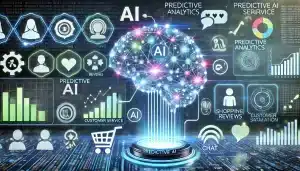In today’s competitive business landscape, customer expectations are at an all-time high. They demand quick solutions, personalized experiences, and proactive service. Meeting these demands isn’t just an added benefit; it’s a necessity for businesses aiming to thrive. This is where Predictive AI becomes indispensable. By leveraging advanced algorithms, machine learning, and data analytics, it empowers businesses to forecast customer behaviors and proactively address their needs. Unlike traditional reactive approaches, where issues are resolved only after they occur, allows businesses to stay one step ahead. It uses historical data—such as purchase history, browsing habits, and previous interactions—to identify patterns and trends, enabling companies to offer tailored solutions even before a customer realizes they need them.
As the business landscape continues to evolve, companies that adopt Predictive AI today will not only meet but exceed customer expectations. They’ll position themselves as forward-thinking leaders in their industries, setting new benchmarks for exceptional service and customer engagement. In this article, we’ll explore the mechanics of Predictive AI, its real-world applications, its benefits, and the challenges businesses face when implementing it.
Understanding Predictive AI
Predictive AI leverages advanced algorithms, machine learning, and data analysis to forecast customer behaviors and anticipate future needs. This powerful tool doesn’t rely on guesswork; instead, it uses historical data, such as purchase history, browsing habits, and past interactions, to make accurate predictions.
How Predictive AI Works:
- Data Collection: Data is gathered from various sources, including websites, apps, purchase history, and social media interactions.
- Analysis: The data is processed to identify trends, patterns, and behaviors.
- Prediction: Insights derived from the analysis are used to predict customer needs and suggest proactive solutions.
For instance, if a customer frequently buys a product every few months, it can notify them when it’s time to reorder, ensuring convenience and satisfaction. This proactive approach builds trust and fosters long-term loyalty.
Anticipating Customer Needs with Predictive AI
The ability to anticipate customer needs is one of Predictive AI’s most valuable attributes. Here are some practical examples of how businesses leverage this technology:
- Personalized Recommendations: E-commerce platforms can recommend products based on browsing history and past purchases. For example, if a customer regularly buys fitness equipment, the AI might suggest related items like yoga mats or protein supplements.
- Restocking Alerts: Subscription services or retailers can alert customers when it’s time to reorder essentials like pet food or skincare products, ensuring a hassle-free experience.
- Proactive Troubleshooting: If an AI system detects frequent issues with a product, it can automatically send solutions—such as troubleshooting guides or replacement offers—before customers even file complaints.
- Tailored Services: Hotels and travel agencies can predict customer preferences based on previous stays, offering personalized options like room upgrades, dining recommendations, or itinerary adjustments.
These use cases highlight how it enhances personalization, ensuring customers feel understood and valued.
Benefits of Predictive AI
Predictive AI transforms customer service and operational efficiency by delivering significant advantages:
1. Improved Customer Experience
Predictive AI enables businesses to anticipate needs and offer timely, personalized solutions. This proactive approach minimizes customer effort, reduces frustration, and creates a seamless, enjoyable experience.
2. Increased Efficiency
By automating routine tasks such as product recommendations and follow-ups, Predictive AI reduces the workload for customer service teams. This allows human agents to focus on resolving complex issues, improving overall productivity.
3. Enhanced Customer Retention
Meeting customer needs before they arise fosters trust and loyalty. Customers are more likely to remain loyal to businesses that anticipate their requirements and provide seamless solutions, reducing churn rates.
4. Data-Driven Insights
It provides actionable insights into customer behavior, helping businesses refine marketing strategies, develop better products, and identify opportunities for growth.
5. Higher ROI
By streamlining operations and increasing customer satisfaction, it improves resource allocation and campaign targeting, resulting in a higher return on investment.

Challenges and Considerations
While Predictive AI offers transformative benefits, its implementation comes with challenges that businesses must address:
1. Data Quality and Accuracy
It relies heavily on accurate, comprehensive data. Incomplete or biased data can lead to flawed predictions, negatively impacting customer experiences. Regular data audits and validation are crucial for ensuring reliable outcomes.
2. Privacy and Ethical Concerns
Balancing personalization with privacy is essential. Businesses must comply with data protection regulations like GDPR and maintain transparency about data collection and usage. Building trust through ethical practices is key to success.
3. Implementation Costs
The initial investment in technology, training, and infrastructure can be high. However, the long-term gains in efficiency and customer retention often outweigh these costs.
4. Integration with Existing Systems
Seamlessly incorporating Predictive AI into existing CRM and workflow systems can be complex. Businesses need clear strategies and expert support to minimize disruptions.
By addressing these challenges proactively, companies can fully harness the potential of Predictive AI while maintaining customer trust.
The Future of Predictive AI in Customer Service
As AI technology evolves, Predictive AI’s capabilities will become even more advanced, unlocking new opportunities for businesses:
- Real-Time Predictions: Future AI systems will offer real-time insights, allowing businesses to respond instantly to customer needs. For instance, e-commerce platforms could provide live product suggestions as customers browse.
- Integration with IoT Devices: It will integrate with smart devices, offering hyper-personalized solutions. For example, a fitness tracker might suggest health plans based on activity data.
- Emotion Recognition: Advanced AI models will analyze customer sentiment and emotions, enabling empathetic, tailored interactions.
- Industry-Specific Applications: From healthcare to retail, it will have tailored applications, such as predicting patient needs in hospitals or menu preferences in restaurants.
These advancements will make Predictive AI an indispensable tool for businesses aiming to deliver exceptional customer experiences and maintain a competitive edge.
Conclusion
Predictive AI is revolutionizing customer service by enabling businesses to anticipate and meet customer needs before they arise. By leveraging this technology, companies can provide personalized experiences, improve efficiency, and foster long-term loyalty.
While challenges like data accuracy and privacy concerns must be addressed, the benefits of Predictive AI far outweigh its drawbacks. Businesses adopting this technology today are not only exceeding current customer expectations but also preparing for a future where proactive service is the standard.
FAQs
1. How does Predictive AI improve customer experiences?
It enhances customer experiences by offering proactive and personalized solutions. It anticipates customer needs and addresses them before they arise, reducing the effort customers need to solve their problems. For example, an AI system can recommend products aligned with a customer’s preferences, send reminders for replenishments, or offer solutions to potential issues before they escalate.
This level of foresight not only creates a seamless experience but also fosters loyalty and satisfaction, as customers feel understood and valued by the brand.
2. Can small businesses benefit from Predictive AI?
Yes, small businesses can significantly benefit from Predictive AI. Many AI tools are scalable and offer cost-effective solutions tailored to smaller enterprises. For example, a small e-commerce store can use Predictive AI to recommend products, send restock reminders, or create personalized offers.
By automating repetitive tasks and providing actionable insights, it enables small businesses to compete with larger companies, enhance customer satisfaction, and optimize resource allocation.
3. How does Predictive AI balance personalization with privacy?
Balancing personalization with privacy is essential to maintaining customer trust. It achieves this by adhering to ethical data collection and usage practices. Businesses must:
- Be transparent about how they collect, store, and use customer data.
- Offer opt-in and opt-out options for customers.
- Comply with data protection regulations like GDPR to ensure responsible data usage.
By prioritizing ethical practices and maintaining transparency, businesses can deliver personalized experiences without compromising customer trust.
4. How does Predictive AI help businesses make data-driven decisions?
It provides businesses with actionable insights by analyzing customer data to uncover trends, preferences, and behaviors. These insights enable businesses to:
- Refine product offerings based on customer demand.
- Optimize marketing campaigns for specific audience segments.
- Allocate resources efficiently by identifying high-ROI opportunities.
With Predictive AI, businesses can make informed decisions that align with customer needs and market trends, ensuring long-term success.
5. What industries benefit most from Predictive AI?
It is versatile and benefits a wide range of industries, including:
- Retail and E-commerce: Product recommendations and restocking alerts.
- Healthcare: Patient care predictions and medication reminders.
- Travel and Hospitality: Personalized itineraries and dining recommendations.
- Finance: Fraud detection and customer behavior forecasting.
- Telecommunications: Predicting churn and improving customer retention strategies.
Any industry that relies on customer interactions can leverage Predictive AI to improve service and operational efficiency.
6. What does the future hold for Predictive AI?
The future of Predictive AI is full of exciting possibilities:
- Real-Time Predictions: AI systems will offer live insights, enabling instant responses to customer needs.
- IoT Integration: AI will collaborate with smart devices to deliver hyper-personalized solutions, such as grocery lists from smart fridges or fitness recommendations from wearable devices.
- Emotion Analysis: Advanced AI models will detect customer sentiment and emotions, enabling empathetic interactions.
- Industry-Specific Innovations: From predicting patient care in healthcare to forecasting menu preferences in restaurants, AI will continue to develop tailored solutions for various sectors.



